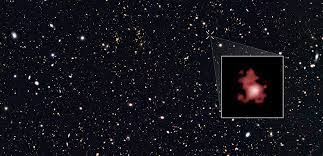Astronomers have made a remarkable discovery with the James Webb Space Telescope: the observation of the oldest “dead” galaxy ever recorded, dating back more than 13 billion years. This ancient galaxy, spotted when the universe was just 700 million years old, challenges our understanding of galactic evolution and offers new insights into the mechanisms that govern star formation and cessation.
Led by the University of Cambridge, an international team of astronomers utilized the unprecedented capabilities of the James Webb Space Telescope to peer back in time and observe a galaxy that ceased forming stars abruptly more than 13 billion years ago. This discovery, detailed in the journal Nature, sheds light on a critical period in the universe’s history and raises intriguing questions about the factors that drive galactic evolution.
The galaxy in question appears to have experienced a rapid burst of star formation followed by an equally swift cessation. This phenomenon, occurring so early in the universe’s evolution, challenges existing models of galactic evolution and suggests that the factors influencing star formation may have been more dynamic than previously thought.
According to Tobias Looser, the paper’s first author from the Kavli Institute for Cosmology, the early universe was characterised by a frenetic period of star formation, fueled by an abundant supply of gas. However, this galaxy’s sudden transition to a “quenched” state—where star formation halts—raises intriguing questions about the mechanisms at play.
Astronomers speculate that various factors, including the presence of supermassive black holes and feedback from star formation, may have contributed to the cessation of star formation in this ancient galaxy. However, the precise cause remains elusive, highlighting the need for further research to unravel the complexities of galactic evolution.
One of the most remarkable aspects of this discovery is the age of the galaxy—just 700 million years after the Big Bang, making it the oldest “dead” galaxy ever observed. This observation, made possible by the James Webb Space Telescope’s unparalleled sensitivity, provides astronomers with a unique glimpse into the early stages of galactic evolution.
Despite its ancient age, this galaxy is relatively low in mass, comparable to the Small Magellanic Cloud—a dwarf galaxy near the Milky Way. This finding challenges previous assumptions about the relationship between galactic mass and the cessation of star formation, suggesting that smaller, fainter galaxies may play a significant role in shaping the early universe.
While the galaxy appears dormant at the time of observation, astronomers speculate that it may have experienced a resurgence in star formation over the past 13 billion years. This possibility underscores the dynamic nature of galactic evolution and highlights the need for continued observation and analysis.
Astronomers are eager to search for additional galaxies like this one, which could provide valuable insights into the processes that govern star formation and cessation in the early universe. By unraveling the mysteries of galactic evolution, we can deepen our understanding of the cosmos and our place within it.
